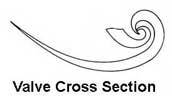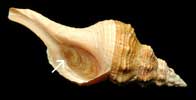| Term | Definition |
| APEX (pl. APICES) |
The first-formed end of a gastropod shell, generally more or less pointed; the tip of the PROTOCONCH or NUCLEAR WHORLS; opposite of BASE; see also: APICAL. | |
| APOPHYSIS (1) (pl. APOPHYSES) |
In bivalves: A projecting peg-like or finger-like structure, functioning as a support for a muscle, e.g., that serving for attachment of pedal muscle in the Pholadidae or adductor muscle in some RUDISTS; = MYOPHORE. See also: APOPHYSIS (2). | |

|
| APOPHYSIS (2) (pl. APOPHYSES) |
In CHITONS, the articulating plate on valves II to VII of a chiton shell. See also: APOPHYSIS (1). | |
| BRANCH (pl. BRANCHIAE) |
The gills; see: GILL for list of the various type of taxonomic groupings. | |
| BRANCHITELLUM (pl. BRANCHITELLA) |
Point on posteroventral margin of OYSTERS nearest to palliobranchial fusion, commonly forming conspicuously projected posteroventral tip on left valve, especially in sickle-shaped oysters; ABORAL end of GILLS points towards it. | |
| CAPSA (pl. CAPSAE) |
[need definition] | |
| CARINA (pl. CARINAE) |
A keel-like part; a prominent knife-edged ridge; = KEEL. See illustration: Composite Gastropod. See also: WHORL, CARINATE; WHORL, BICARINATE. | |
| CERAS (pl. CERATA) |
On of the slender, club-shaped or horn-shaped dorsal appendages in the NUDIBRANCHIA and ASCOGLOSSA, which either lie separately or in several rows or may be clustered together in tufts and palmate bunched; they contain blood from the HAEMOCOEL and are invaded also by tubular branches of the digestive gland which, as evolution proceeds, becomes deployed on On of the slender, club-shaped or horn-shaped dorsal appendages in the Nudibranchia and Ascoglossa, which either lie separately or in several rows or may be clustered together in tufts and palmate bunched; they contain blood from the haemocoel and are invaded also by tubular branches of the digestive gland which, as evolution proceeds, becomes deployed on the dorsal surface; see also: CLADOHEPATIC; HOLOHEPATIC. See illustration: Composite Nudibranch. | |
| CINGULUM (pl. CINGULA) |
A band or girdle, e.g., a band of color or raised sculpture. | |
| COSTA (pl. COSTAE) |
A round-topped sculptural element, stronger than a cord, usually formed by periodic thickening of the outer lip in gastropods. Moderately broad and prominent elevation of surface of shell, directed radially or otherwise; see also: COSTELLA. | |
| CRENULATE (pl. CRENULATIONS) |
Same as CRENATE, but implying smaller or finer divisions. See illustration: Composite Bivalve. See also: DENTICULATION | |
| CRUS (pl. CRURA) |
Pairs of diverging ridges on the hinge of some bivalves, resembling teeth. | |
| CTENIDIUM (pl. CTENIDIA) |
The respiratory organ in the Mollusca; a GILL which has been modified for food-gathering in the BIVALVIA; see also: DIBRANCH; EULAMELLIBRANCH; FILIBRANCH; LAMELLIBRANCH; PROTOBRANCH; PSEUDOLAMELLIBRANCH; SEPTIBRANCH; TECTIBRANCH; TETRABRANCH. | |
| FIMBRIA (pl. FIMBRIAE) |
A border or fringe; see also: FIMBRIATE; FIMBRIATION. | |
| GENUS (pl. GENERA) |
[need definition] | |
| GLOCHIDIUM (pl. GLOCHIDIA) |
The LARVAE of freshwater Unionacean bivalves. As a dispersal mechanism, this larva temporarily attaches itself to the gills of fish. | |
| HECTOCOTYLUS (pl. HECTOCOTYLI) |
A specially modified ARM of CEPHALOPODS which is used to transfer SPERMATOPHORES from the male to the female.; see also: SPADIX; TENTACLE. | |
| LABIUM (pl. LABIA) |
The INNER LIP of the APERTURE; see also: PERISTOME. | |
| LAMELLA (pl. LAMELLAE) |
A thin plate or scale, generally more or less erect; see also: LAMINA; RUFFLED; SQUAMOUS; WEBBING. | |
| LAMINA (pl. LAMINAE) |
A plate or scale, generally parallel to the shell surface. | |
| LARVA (pl. LARVAE) |
The juvenile stage, following the egg, of many forms of life; usually provides a mechanism for dispersal of the species; see also: DORATOPSIS; ECHINOSPIRA; GLOCHIDIUM; LECITHOTROPHIC; NEOTENY; PEDIVELIGER; PLANKTOTROPHIC; PROTOCONCH; RHYNCHOTEUTHIS; SPAT; TROCHOPHORE; VELIGER. | |
| LIG (pl. LIGS) |
A short, common name for a tree snail of the genus Liguus; see also: LIG POLE. | |
| LIRA (pl. LIRAE) |
Fine linear elevation on shell surface or within OUTER LIP (Cox, 1960); this feature is often on the inner surface of the outer lip of the APERTURE; see also: STRIA. | |
| NOMEN NUDUM NOM. NUD. (pl. NOMINA NUDA) |
A name published without sufficient documentation to validate it under the International Code (ICZN); such a name may be used later if given with a proper description. | |
| OPERCULUM (pl. OPERCULA) |
A generally oval, lid-like, CORNEUS or CALCAREOUS structure, situated on the posterior end of the FOOT of many gastropods, that closes off the APERTURE when the animal withdraws into its shell; see also: CONCENTRIC; EPIPHRAGM; MULTISPIRAL; OLIGOGYROUS; PAUCISPIRAL; POLYGYROUS; TRAP DOOR; UNGUICULATE, RIGICLAUDENT, FLEXICLAUDENT. See the website on opercula: The Humble Operculum Photo: Triplofusus giganteus (Kiener, 1840) |
|

|
| PAPILLA (pl. PAPILLAE) |
Any small bump or small projection. | |
| PLICA (pl. PLICAE) |
A FOLD; see also: PLAIT; RUGA. | |
| PROPODIUM (pl. PROPODIA) |
A slit across the anterior margin of the foot of gastropods which coincides with the boundary between the anterior part of the FOOT and the MESOPODIUM; see also: MESOPODIUM. | |
| PUNCTUM (pl. PUNCTA, never PUNCTAE) |
A pinprick-like depression of the surface; see also: PIT. | |
| RADULA (pl. RADULAE) |
A ribbon which supports rows of chitinous teeth; this characteristic is found only in molluscs; see also:
ASCUS SAC;
CUSPIDOBLAST;
ODONTOPHORE;
RADULA FORMULA;
UNISERIATE. Mikkelsen, P.S. 1985. A rapid method for slide mounting of minute radulae, with a bibliography of radula mounting techniques. Nautilus 99(2-3):62-65. [request a reprint! or download a copy] |
|
| RAMUS (pl. RAMI) |
A branch or leaf-like process, generally borne distally on a SPINE. | |
| RUGA (pl. RUGAE) |
An irregular fold in the surface SCULPTURE. | |
| STRIA (pl. STRIAE) |
Very narrowly INCISED shallow groove (Cox, 1960); this term especially used to refer to one of a series of parallel or concentric grooves (= striae); see also: LIRA; GROOVE; RIB-STRIAE; RIB. | |
| SULCUS (pl. SULCI) |
A deep slit, fissure, or furrow; see also: SULCUS, ANAL; SULCUS, AURICULAR. | |
| TAXON (pl. TAXA) |
A grouping of organisms under a "common" (i.e., single) name; a unit of classification at any level, implying biological relationship. | |
| UMBO (pl. UMBONES) |
Region of VALVE (in bivalves) surrounding point of maximum curvature of longitudinal DORSAL profile and extending to the BEAK, when not coinciding with it (many authors treat "beak" and "umbo" as synonymous, but with most shells, two distinct terms are needed). See illustration: Composite Bivalve. See also: NATES; PRODISSOCONCH.
See: Bivalve terminology, Anatomy of bivalves by Marlo Krisberg. |
|
| VARIX (pl. VARICES) |
A thickened or extensive axial ridge indicative of a resting stage in the growth of the mollusc, as reflected in the shell; in some cases including all structures associated with interruption of growth. See illustration: Composite Gastropod. See also: INTERVARICAL SPACE; AXIAL RIB; LABIAL RIB; SCLEROCHRONOLOGY. | |
| VELUM (pl. VELA) |
The locomotory organ of a VELIGER: a membranous structure composed of two or more lobes fringed with minute, hair-like structures or CILIA. | |